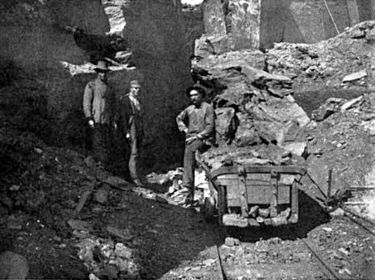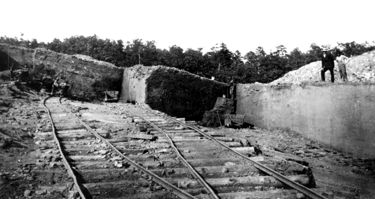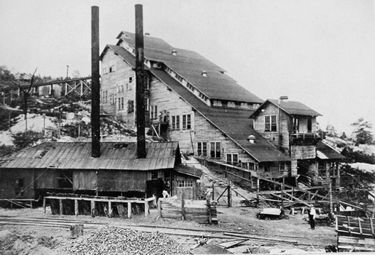Helen Bess Mine
The Helen Bess Mine is a former red iron ore mine which supplied Wallace McElwain's Cahaba Iron Works (Irondale Furnace) beginning in 1864. It is, after the Eureka No. 1 Mine, the earliest commercial ore mine on Red Mountain.
The mine site was situated on the crest of Red Mountain, with surface mining on the north slope and drift mining and at least one underground slope in the flanks of a ravine in the south side.
Originally the soft red ore of the "Big seam", which formed an outcrop, was quarried from the surface and moved by tramway to the furnace site. The surface works and tramway were destroyed by Emory Upton's division during Wilson's Raid on industrial sites in central Alabama in late March 1865.
The mine operation was resumed after the war. By 1909 a sloping mine shaft 500 feet long had been dug into the "Irondale seam" with seven headings on each side at 60-foot intervals. Another bed, the "Ida seam", was also accessible, but produced harder, lower quality ore. The ores from the Big and Irondale seams ranged from 32 to 35% iron content, 30 to 32% silica, and 6 to 8.5% lime.
In the 1880s, a spur from the Red Gap branch of L & N's Birmingham Mineral Railroad was laid into the base of the ravine. Miners would come to the site by taking a streetcar to 42nd Street at Cliff Road in Mountain Terrace and walking the rest of the way up the mountainside.
At that time, the mine was operated by the Birmingham Ore and Mining Company. Additional surface facilities, such as an ore concentration plant, were constructed during World War I. The mine was closed in 1920 and a subsequent fire destroyed the surface structures.
The Timberlane Apartments were built over part of the mining area on the southern slope by McConnell-White-Terry Realty in 1967. The company chose to preserve the remains of the mining operations in their redevelopment. The foundations of the pilot mill and boiler house are visible near the entrance drive.
The Blenheim Place subdivision, developed in the 1980s, was built over some of the westernmost mining areas.
References
- United States Geological Survey (1910) Bulletin No. 400
- Phillips, William Battle (1912) "Iron Making in Alabama. Vol. 7 of the Geological Survey of Alabama. Brown Printing Co.
- Ennis, William (March 1941) "Ruined Ore Plant is Dandy Place For Spooks to Hide."
- White, Marjorie Longenecker (1981) The Birmingham District: An Industrial History and Guide. Birmingham: Birmingham Historical Society ISBN 9990230099
External links
- Photos from inside mine on Flickr.com


